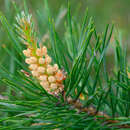Biology
provided by Arkive
Scots pines shed their pollen in May in copious amounts. The male pollen-producing flowers are located at the base of new shoots. The female cones grow at the tips of stronger new shoots and, once fertilised, ripen after two years. The needles are not shed each year but remain on the tree for two or even three years. Their waxy coating protects against excessive water-loss and the needles have fewer pores than the leaves of deciduous trees.
Pines seal damage to their trunks and branches by producing resin; a sticky, viscose secretion that protects the tree against entry by insects and fungal spores. This resin sometimes traps unwary creatures and preserves them. When this resin becomes hard it forms amber, sometimes surviving for millions of years, and can provide a unique record of the insect life that lived in the ancient pine forests. Artists and craftsmen have also found pine a useful source of raw materials. The resin can be refined and the volatile component, turpentine, is used as a solvent. The remaining constituent, rosin, has been used to coat zinc or copper plates used in printing engraved images, and for dressing violin bows.
The timber, though classified as 'softwood', is strong and used for a huge range of products, from house and boat-building to furniture, toys and railway sleepers. Once treated with preservative, it weathers well and lasts for years. Many square hectares of pine forest are planted each year to supply industry with timber. The sweet fragrance of pine has even found its way into our homes in the form of scented cleaning products!
Conservation
provided by Arkive
There are currently no conservation projects for Scots pine.
Description
provided by Arkive
Scots pine is one of only three native conifers found in the UK and our only true cone-bearing tree. Although Scots pine can trace its earliest British ancestry back to the end of the Ice Age, it is something of an anomaly in that relatively few of the trees living today are directly descended from those early colonisers.
Originally forming extensive forests over most of Britain, a change in the climate to warmer temperatures some 5000 years ago favoured deciduous trees and pushed the range of the Scots pine northwards, out of most of England and Wales. In the seventeenth century, a combination of tree-felling for industrial use and the notorious Highland clearances all but eradicated the tree in northern Scotland. There was estimated to be little more than 10,000 hectares of native Scots pine forest left in Scotland by the 1970s.
This tree can grow as high as 40 metres and often has a trunk that is extensively forked. The bark is reddish-brown and forms flaky plates. In common with other pines, the tree bears stiff waxy needles instead of flattened leaves. These grow in pairs from the twigs and are between five and seven centimetres long. The tree also bears its seeds in cones, small egg-shaped woody structures which appear green and resinous in their first year, later drying to produce the familiar mini-pineapple shaped pinecones from which the seeds are dispersed.
Habitat
provided by Arkive
The tree prefers light sandy soils and lower altitudes. It has been planted as a windbreak in some regions, notably the East Anglian Breckland. It does not like areas with high rainfall or sea winds.
Range
provided by Arkive
Scots pine ranges across Europe and Asia, from the Iberian peninsular and Turkey in the south to the edge of the Siberian tundra. It has also been introduced to other countries.
Status
provided by Arkive
Common in the UK
Threats
provided by Arkive
Scots pine is not a threatened species but for centuries it has been cleared from much of its British range. Today, trees are being allowed to self-set and grow over much of the area where they occurred before the great clearances of the 17th century.

